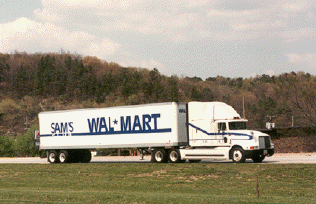Vallejo Rick Smith of WARN and I putting a lot of miles on a rental with $4.45 per gallon gas all over Central Valley and Southern California over coming days on the Wal-Mart trail. We are looking and talking to a lot of people about some very specific issues, but none are more fundamental than whether and where Wal-Mart may be assembling property and plans to build new distribution centers — the heart of the Wal-Mart logistical vascular system.
In Vallejo we met with Carlos Borda of the Teamsters, who has been a rock of support on the WARN program in California, and Phil Tucker, the mainstay of California Healthy Communities, our partner and ally. What engaged most of our energy were two things that have recently emerged from WARN research. One is that Wal-Mart is once again ramping up supercenter expansion in the Central Valley around Sacramento and in the growing southern California counties of San Bernardino and Riverside. The other was the critical issue of distribution centers and a sense that maybe Wal-Mart was preparing to throw in the towel in Merced where we and others have now had them bottled up for 2 years and look for other locations in the Bay Area, while there are accelerating plans in the south as well.
WARN research indicates that someone is preparing to put a distribution center together in the Tracey area. Tracey is a junction point for major highways below the Bay Area and already a neighborhood chuck full of distribution centers which would make this an even more difficult fight. In southern California proposals seem to be moving forward in several locations to service expansion including Barstow where only a week ago plans went to some of the public bodies. There are other rumors we have to track down in coming days.
Without new distribution centers the Wal-Mart business model simply does not work. Each one can service 100 — 125 stores. Without building them they can’t build the stores, simple as that. Carlos told stories from his members of seeing garages with Wal-Mart goods everywhere on the road because the company can’t consolidate. Progress on the Change to Win port organizing campaign could also be a critical piece in this puzzle if there were organizing breakthroughs that could be leveraged to move inland.
The company is clearly mobilizing for a major offensive in California, one of the major frontiers that it has really not conquered yet. Our job with a lot of others has to be to meet this initiative aggressively and up the ante as well.
Our simple argument is that the time is now or never. Luckily, it seems a lot of people are coming to the same conclusion.
